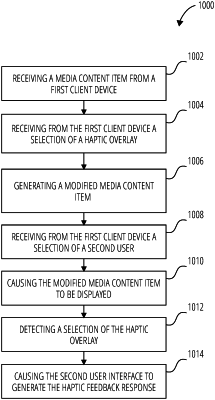| CPC G06F 3/016 (2013.01) [G06F 3/04883 (2013.01); H04N 5/272 (2013.01); H04N 2005/2726 (2013.01)] | 18 Claims |

|
1. A system comprising:
a processor; and
a memory having instructions thereon, when executed by the processor, causes the system to be configured to:
receive a media content item from a first client device, wherein the first client device is associated with a first user;
receive from the first client device a selection of a haptic overlay to be applied to a portion of the media content item, wherein the haptic overlay is associated with a haptic feedback response;
generate a modified media content item by overlaying the haptic overlay on the portion of the media content item;
receive from the first client device a selection of a second user, wherein a second client device is associated with the second user;
cause the modified media content item to be displayed by a second user interface of the second client device;
detect a selection of the haptic overlay from the second client device, wherein detecting the selection of the haptic overlay comprises receiving a touch input from the second user on the haptic overlay being displayed on the second user interface,
wherein the touch input is received in response to the second user maintaining touch contact with the haptic overlay for a period of time;
in response to detecting the selection of the haptic overlay, cause the second user interface to generate the haptic feedback response that increases in strength during the period of time that the second user is maintaining touch contact with the haptic overlay;
detect a predetermined gesture by the first user captured in the modified media content item, wherein the predetermined gesture is associated with a predetermined gesture haptic feedback response or a predetermined gesture augmentation; and
in response to detecting the predetermined gesture,
cause the second user interface to generate the predetermined gesture haptic feedback response, wherein the predetermined gesture haptic feedback response is different from the haptic feedback response, or
cause the second user interface to generate the predetermined gesture augmentation.
|